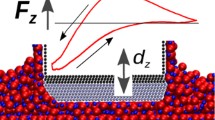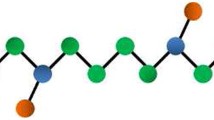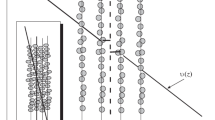Abstract
The rheological behavior of an ionic liquid was investigated by means of molecular dynamics simulations with experimental contribution, under conditions close to those found in the elastohydrodynamic and the very-thin film lubrication regimes. The molecular model was applied to nearly 200 temperature–pressure–shear rate cases, without any parameter adjustment. Experiments were conducted on a rheometer and a high-pressure falling-body viscometer. This unique combination of numerical and experimental tools has enabled the full description of the ionic liquid rheological response to extreme conditions of temperature, pressure and shear rate. In the linear domain, a very good consistency between the two computational approaches (nonequilibrium molecular dynamics, equilibrium molecular dynamics via the Green–Kubo formalism) and the experiments was obtained on the Newtonian viscosity. Reliable values of the pressure–viscosity coefficient, another rheological characteristic necessary for predicting film thickness in the regimes of interest in this work, were inferred. Compared with a conventional lubricant of almost identical Newtonian viscosity, the pressure–viscosity coefficient of the ionic fluid is much lower, its variations with temperature remaining, however, very similar. The application of the time–temperature–pressure superposition principle and the regression to the Carreau equation for describing the nonlinear domain have revealed, for the first time, significant variations in the exponent of the Carreau model which have been correlated with the changes in temperature and pressure.









Similar content being viewed by others
Abbreviations
- a η :
-
Viscosity shift factor for the application of the time–temperature–pressure superposition
- \(a_{{\dot{\gamma }}}\) :
-
Shear-rate shift factor for the application of the time–temperature–pressure superposition
- d :
-
Typical ion size (m)
- D :
-
Average self-diffusion coefficient (m2 s−1)
- \(D_{\text{F}}\) :
-
Fragility parameter (VFT model)
- N :
-
Exponent of the Carreau law (−)
- p :
-
Pressure (Pa)
- \(p_{\text{Ref}}\) :
-
Pressure at the reference state (Pa)
- R 2 :
-
Coefficient of correlation from data regression (−)
- t rel :
-
Relaxation time (s)
- T :
-
Temperature (K)
- T g(p):
-
Glass transition temperature at pressure p (K)
- T Ref :
-
Temperature at the reference state (K)
- \(T_{\infty }\) :
-
Vogel temperature at which the viscosity diverges (VFT model, K)
- α :
-
Pressure–viscosity coefficient (GPa−1)
- \(\alpha^{*}\) :
-
Reciprocal asymptotic isoviscous pressure coefficient, as proposed by Blok (GPa−1)
- η :
-
Viscosity (Pa s)
- η g :
-
Viscosity at the glass transition (=1012 Pa s)
- η 0 :
-
Newtonian viscosity (Pa s)
- \(\eta^{*}\) :
-
Reduced viscosity (Pa s)
- \(\eta_{\infty }\) :
-
Viscosity extrapolated to infinite temperature (VFT model, Pa s)
- \(\dot{\gamma }\) :
-
Shear rate (s−1)
- \(\dot{\gamma }_{\text{c}}\) :
-
Critical shear rate, at the onset of the nonlinear behavior (s−1)
- \(\dot{\gamma }^{*}\) :
-
Reduced shear rate (s−1)
- ρ :
-
Density (kg m−3)
- ρ Ref :
-
Density at the reference state (kg m−3)
References
Gupta, S.A., Cochran, H.D., Cummings, P.T.: Shear behavior of squalane and tetracosane under extreme confinement. III. Effect of confinement on viscosity. J. Chem. Phys. 107(23), 10335–10343 (1997)
McCabe, C., Cui, S., Cummings, P.T., Gordon, P.A., Saeger, R.B.: Examining the rheology of 9-octylheptadecane to giga-pascal pressures. J. Chem. Phys. 114(4), 1887–1891 (2001)
McCabe, C., Manke, C.W., Cummings, P.T.: Predicting the Newtonian viscosity of complex fluids from high strain rate molecular simulations. J. Chem. Phys. 116(8), 3339–3342 (2002)
Kioupis, L.I., Maginn, E.J.: Rheology, dynamics, and structure of hydrocarbon blends: a molecular dynamics study of n-hexane/n-hexadecane mixtures. Chem. Eng. J. 74, 129–146 (1999)
Kioupis, L.I., Maginn, E.J.: Impact of molecular architecture on the high-pressure rheology of hydrocarbon fluids. J. Phys. Chem. B 104, 7774–7783 (2000)
Bair, S., McCabe, C., Cummings, P.T.: Comparison of nonequilibrium molecular dynamics with experimental measurements in the nonlinear shear-thinning regime. Phys. Rev. Lett. 88(5), 058302-1–058302-4 (2002)
Bair, S., McCabe, C., Cummings, P.T.: Calculation of viscous EHL traction for squalane using molecular simulation and rheometry. Tribol. Lett. 13(4), 251–254 (2002)
Ramasamy, U.S., Bair, S., Martini, A.: Predicting pressure–viscosity behavior from ambient viscosity and compressibility: challenges and opportunities. Tribol. Lett. 57(2), 11 (2015)
Blok, H.: Inverse problems in hydrodynamic lubrication and design directives for lubricated flexible surfaces. In: Proceedings International Symposium on Lubrication and Wear, Houston. McCutchan Publishing Corp., Berkeley (1963)
Liu, P., Yu, H., Ren, N., Lockwood, F.E., Wang, Q.J.: Pressure–viscosity coefficient of hydrocarbon base oil through molecular dynamics simulations. Tribol. Lett. 60(3), 34 (2015)
Ye, C., Liu, W., Chen, Y., Yu, L.: Room-temperature ionic liquids: a novel versatile lubricant. Chem. Commun. 21, 2244–2245 (2001)
Minami, I.: Ionic liquids in tribology. Molecules 14(6), 2286–2305 (2009)
Maginn, E.J.: Molecular simulation of ionic liquids current status and future opportunities. J. Phys. Condens. Matter 21(37), 373101 (2009)
Zhou, F., Liang, H., Liu, W.: Ionic liquid lubricants: designed chemistry for engineering applications. Chem. Soc. Rev. 38, 2590–2599 (2009)
Palacio, M., Bhushan, B.: A review of ionic liquids for green molecular lubrication in nanotechnology. Tribol. Lett. 40(2), 247–268 (2010)
Tokuda, H., Hayamizu, K., Ishii, K., Susan, M.A.B.H., Watanabe, M.: Physicochemical properties and structures of room temperature ionic liquids. 2. Variation of alkyl chain length in imidazolium cation. J. Phys. Chem. B 109(13), 6103–6110 (2005)
Tokuda, H., Tsuzuki, S., Susan, M.A.B.H., Hayamizu, K., Watanabe, M.: How ionic are room-temperature ionic liquids? An indicator of the physicochemical properties. J. Phys. Chem. B 110(39), 19593–19600 (2006)
Voeltzel, N., Gulliani, A., Vergne, P., Fillot, N., Joly, L.: Nanolubrication by ionic liquids: molecular dynamics simulations reveal an anomalous effective rheology. Phys. Chem. Chem. Phys. 35(17), 23226–23235 (2015)
Electronic Supplementary Information: ESI. Phys. Chem. Chem. Phys. 35(17), 23226–23235 (2015)
Canongia Lopes, J.N., Deschamps, J., Pádua, A.A.H.: Modeling ionic liquids using a systematic all-atom force field. J. Phys. Chem. B 108, 2038–2047 (2004)
Salanne, M.: Simulations of room temperature ionic liquids: from polarizable to coarse-grained force fields. Phys. Chem. Chem. Phys. 17, 14270–14279 (2015)
Schroder, C.: Comparing reduced partial charge models with polarizable simulations of ionic liquids. Phys. Chem. Chem. Phys. 14, 3089–3102 (2012)
Chaban, V.: Polarizability versus mobility: atomistic force field for ionic liquids. Phys. Chem. Chem. Phys. 13, 16055–16062 (2011)
Müller-Plathe, F.: Reversing the perturbation in nonequilibrium molecular dynamics: an easy way to calculate the shear viscosity of fluids. Phys. Rev. E 59, 4894–4898 (1999)
Allen, M.P., Tildesley, D.J.: Computer Simulation of Liquids. Oxford University Press, Oxford (1989)
Bair, S., Vergne, P., Querry, M.: A unified shear-thinning treatment of both film thickness and traction in EHD. Tribol. Lett. 18(2), 145–152 (2005)
Bair, S.: A routine high-pressure viscometer for accurate measurements to 1 GPa. Tribol. Trans. 47(3), 356–360 (2004)
Angell, C.A.: Formation of glasses from liquids and biopolymers. Science 276, 1924–1935 (1995)
Ahosseini, A., Scurto, A.M.: Viscosity of imidazolium-based ionic liquids at elevated pressures: cation and anion effects. Int. J. Thermophys. 29, 1222–1243 (2008)
Bair, S., Mary, C., Bouscharain, N., Vergne, P.: An improved Yasutomi correlation for viscosity at high pressure. Proc. Inst. Mech. Eng. J J. Eng. Tribol. 227(9), 1056–1060 (2013)
Hamrock, B.J., Dowson, D.: Isothermal elastohydrodynamic lubrication of point contacts, part III—fully flooded results. Trans. ASME J. Lubr. Technol. 99(2), 264–276 (1977)
Chaomleffel, J.P., Dalmaz, G., Vergne, P.: Experimental results and analytical predictions of EHL film thickness. Tribol. Int. 40(10–12), 1543–1552 (2007)
Bair, S.: High-Pressure Rheology for Quantitative Elastohydrodynamics. Elsevier, Amsterdam (2007)
Pensado, A.S., Comuñas, M.J.P., Fernández, J.: The pressure-viscosity coefficient of several ionic liquids. Tribol. Lett. 31(2), 107–118 (2008)
Harris, K.R., Kanakubo, M., Woolf, L.A.: Temperature and pressure dependence of the viscosity of the ionic liquids 1-hexyl-3-methylimidazolium hexafluorophosphate and 1-butyl-3-methylimidazolium bis(trifluoromethylsulfonyl)imide. J. Chem. Eng. Data 52, 1080–1085 (2007)
Vergne, P.: Comportement Rhéologique des Lubrifiants et Lubrification : Approches Expérimentales. Habilitation Thesis (in French), INSA de Lyon, Lyon, France. 28 March 2002
Acknowledgments
The authors, in particular N. Voeltzel, P. Vergne, N. Fillot and N. Bouscharain are grateful to the SKF company for its funding through the Research Chair “Lubricated Interfaces for the Future,” signed with LaMCoS and INSA-Lyon Foundation. They are grateful to Professor Josefa Fernández, from the Universidade de Santiago de Compostela (Spain), for her interest in the topic and for sharing some results on ionic liquids, which have contributed to this work. Our last thanks go to the Fédération Lyonnaise de Modélisation et Sciences Numériques (FLMSN) for providing computing resources via the P2CHPD facility.
Author information
Authors and Affiliations
Corresponding author
Rights and permissions
About this article
Cite this article
Voeltzel, N., Vergne, P., Fillot, N. et al. Rheology of an Ionic Liquid with Variable Carreau Exponent: A Full Picture by Molecular Simulation with Experimental Contribution. Tribol Lett 64, 25 (2016). https://doi.org/10.1007/s11249-016-0762-z
Received:
Accepted:
Published:
DOI: https://doi.org/10.1007/s11249-016-0762-z




